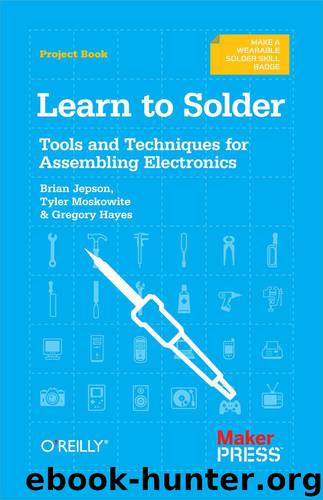Learn to Solder: Tools and Techniques for Assembling Electronics by Brian Jepson & Tyler Moskowite & Gregory Hayes

Author:Brian Jepson & Tyler Moskowite & Gregory Hayes [Brian Jepson]
Language: eng
Format: epub
Tags: General, Technology & Engineering, Electronics, Materials Science, Industrial Design, TECHNOLOGY & ENGINEERING / Electronics / General
ISBN: 9781449337247
Publisher: O'Reilly Media
Published: 2012-05-11T06:46:29+00:00
Figure 2-4. Inserting an LED
Figure 2-5. Bending out the leads
Knowing Which Way a Component Goes In
Some components don’t care which way you put them in: resistors, some capacitors (such as the one that comes with this kit), and many other components fall into that category. On the other hand, LEDs are polarized; electrical current will only flow through them in one direction. So if you put your LED in backwards, it won’t light up at all. You can determine an LED’s polarity in a couple of ways: First, the longer of the two leads is the positive (+), and the shorter is negative (-).
Second, look closely at the bottom of the LED and examine the ring that bulges out around it. There is a flattened part of that ring that indicates the side of the LED that’s negative (-). You can see this flattened side on the right in Figure 2-6.
With ICs, this also matters. Every pin has a specific function, and there will be one or more pins for positive (+) and one or more pins for negative (-).
Download
This site does not store any files on its server. We only index and link to content provided by other sites. Please contact the content providers to delete copyright contents if any and email us, we'll remove relevant links or contents immediately.
| Automotive | Engineering |
| Transportation |
Whiskies Galore by Ian Buxton(41544)
Introduction to Aircraft Design (Cambridge Aerospace Series) by John P. Fielding(32897)
Small Unmanned Fixed-wing Aircraft Design by Andrew J. Keane Andras Sobester James P. Scanlan & András Sóbester & James P. Scanlan(32583)
Craft Beer for the Homebrewer by Michael Agnew(17940)
Turbulence by E. J. Noyes(7720)
The Complete Stick Figure Physics Tutorials by Allen Sarah(7153)
Kaplan MCAT General Chemistry Review by Kaplan(6606)
The Thirst by Nesbo Jo(6458)
Bad Blood by John Carreyrou(6286)
Modelling of Convective Heat and Mass Transfer in Rotating Flows by Igor V. Shevchuk(6232)
Learning SQL by Alan Beaulieu(6048)
Weapons of Math Destruction by Cathy O'Neil(5855)
Man-made Catastrophes and Risk Information Concealment by Dmitry Chernov & Didier Sornette(5674)
Digital Minimalism by Cal Newport;(5399)
Life 3.0: Being Human in the Age of Artificial Intelligence by Tegmark Max(5201)
iGen by Jean M. Twenge(5175)
Secrets of Antigravity Propulsion: Tesla, UFOs, and Classified Aerospace Technology by Ph.D. Paul A. Laviolette(5024)
Design of Trajectory Optimization Approach for Space Maneuver Vehicle Skip Entry Problems by Runqi Chai & Al Savvaris & Antonios Tsourdos & Senchun Chai(4851)
Electronic Devices & Circuits by Jacob Millman & Christos C. Halkias(4760)
